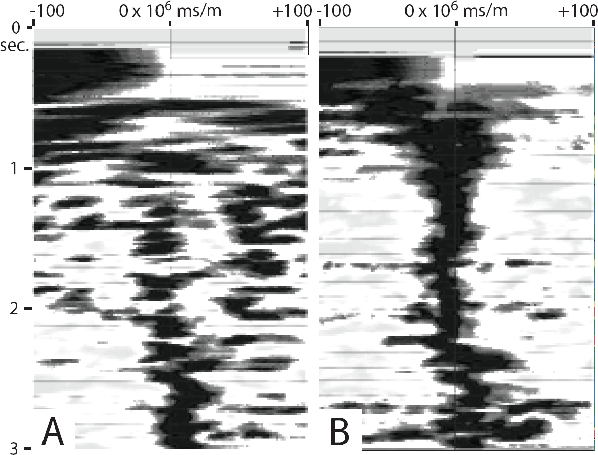




Next: Conclusions
Up: Examples
Previous: Examples
Figure (![[*]](http://sepwww.stanford.edu/latex2html/cross_ref_motif.gif) ) shows dips estimated on a stacked section and semblance panels for both a small (3x3) and a large (11x11) super-gather, computed without (upper panels) and with dip corrections (lower panels). In the large super-gather, the results computed without dips are noisier than those from the small super-gather. For this reason, data processors often prefer to use small super-gathers in areas with significant structure. The best semblance panel is obtained when the large super-gather is combined with the dip correction. Note that the largest improvement is achieved in the near-surface. The higher frequency of the data in this region makes it more likely that the super-gathers cause degradation of the semblance peaks in uncorrected panels. The minimum dip that is spatially aliased is inversely proportional to the temporal frequency of the data, so higher frequencies make it more likely that uncorrected travel-time surfaces cut laterally across reflections.
) shows dips estimated on a stacked section and semblance panels for both a small (3x3) and a large (11x11) super-gather, computed without (upper panels) and with dip corrections (lower panels). In the large super-gather, the results computed without dips are noisier than those from the small super-gather. For this reason, data processors often prefer to use small super-gathers in areas with significant structure. The best semblance panel is obtained when the large super-gather is combined with the dip correction. Note that the largest improvement is achieved in the near-surface. The higher frequency of the data in this region makes it more likely that the super-gathers cause degradation of the semblance peaks in uncorrected panels. The minimum dip that is spatially aliased is inversely proportional to the temporal frequency of the data, so higher frequencies make it more likely that uncorrected travel-time surfaces cut laterally across reflections.
Figure (![[*]](http://sepwww.stanford.edu/latex2html/cross_ref_motif.gif) ) shows RMO panels for 11x11 super-gathers of time-migrated CMPs at the same location as for the previous gathers. Where the data are migrated with the correct velocity, the semblance is centered on zero r in the middle of the panel. Semblance maxima at negative r indicate over-migrated data, while maxima at positive r indicate under-migrated data. The effect of the dip corrections is similar for the PSTM gathers as for the semblance panels.
) shows RMO panels for 11x11 super-gathers of time-migrated CMPs at the same location as for the previous gathers. Where the data are migrated with the correct velocity, the semblance is centered on zero r in the middle of the panel. Semblance maxima at negative r indicate over-migrated data, while maxima at positive r indicate under-migrated data. The effect of the dip corrections is similar for the PSTM gathers as for the semblance panels.
land_nmo
Figure 6 NMO semblance panels computed without dip corrections for 3x3 (A) and 11x11 (B) super-gathers; panels computed with dip corrections 3x3 (C) and 11x11 (D) super-gathers. The dip corrections improve the semblance quality for both the small and larger super-gathers. Note that without the correction, the smaller super-gather yields superior results while the opposite is true with the correction.
 land_rmo
land_rmo
Figure 7 RMO semablance panels computed on an 11x11 super-gather without (A) and with (B) dip corrections. As for NMO velocity analysis, the dip corrections make the panel easier to pick.






Next: Conclusions
Up: Examples
Previous: Examples
Stanford Exploration Project
5/6/2007
![[*]](http://sepwww.stanford.edu/latex2html/cross_ref_motif.gif) ) shows RMO panels for 11x11 super-gathers of time-migrated CMPs at the same location as for the previous gathers. Where the data are migrated with the correct velocity, the semblance is centered on zero r in the middle of the panel. Semblance maxima at negative r indicate over-migrated data, while maxima at positive r indicate under-migrated data. The effect of the dip corrections is similar for the PSTM gathers as for the semblance panels.
) shows RMO panels for 11x11 super-gathers of time-migrated CMPs at the same location as for the previous gathers. Where the data are migrated with the correct velocity, the semblance is centered on zero r in the middle of the panel. Semblance maxima at negative r indicate over-migrated data, while maxima at positive r indicate under-migrated data. The effect of the dip corrections is similar for the PSTM gathers as for the semblance panels.

